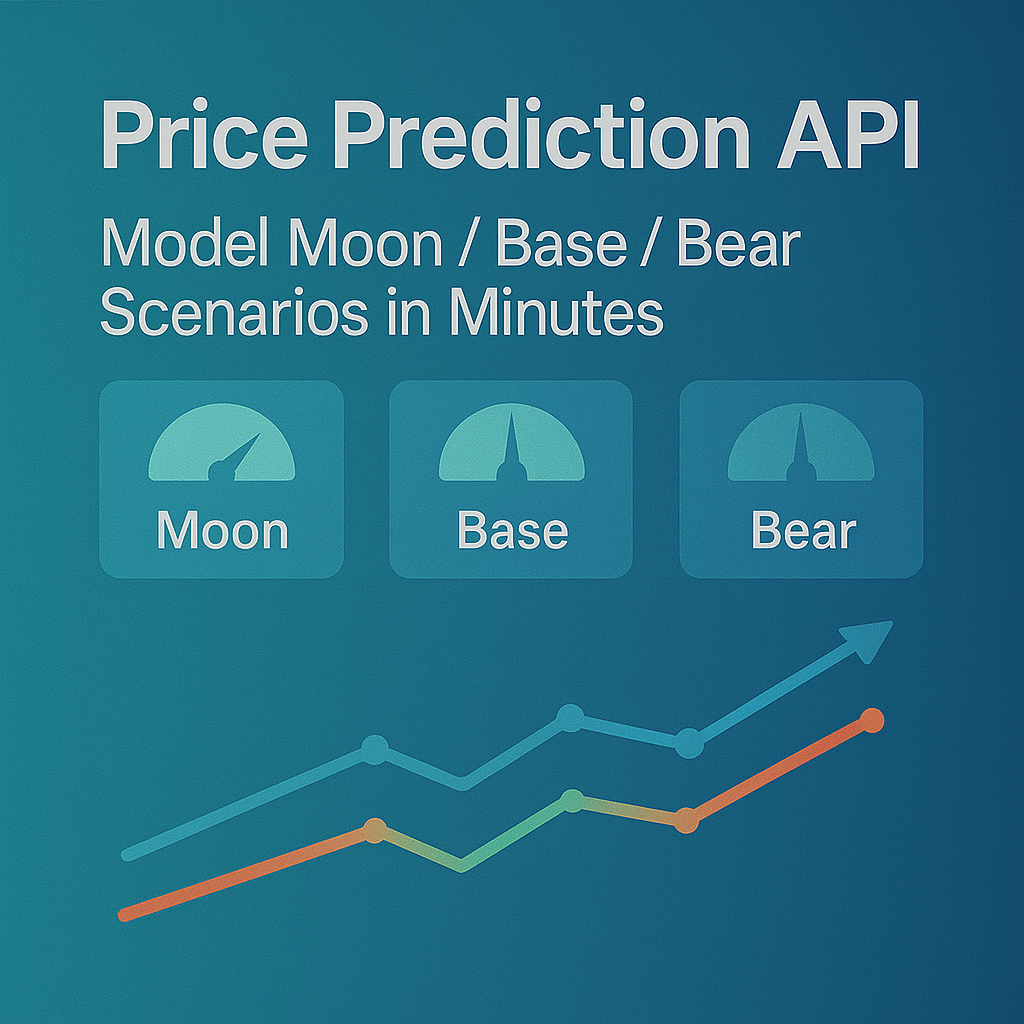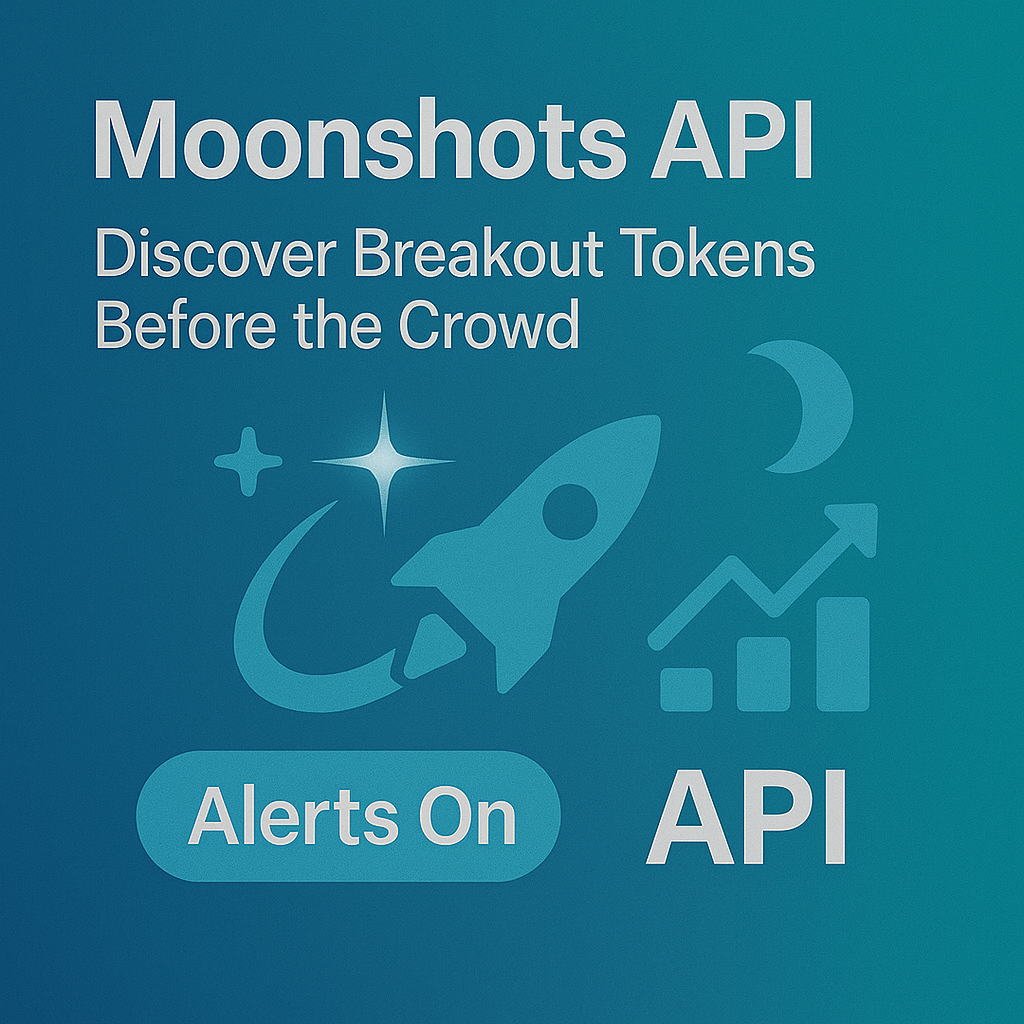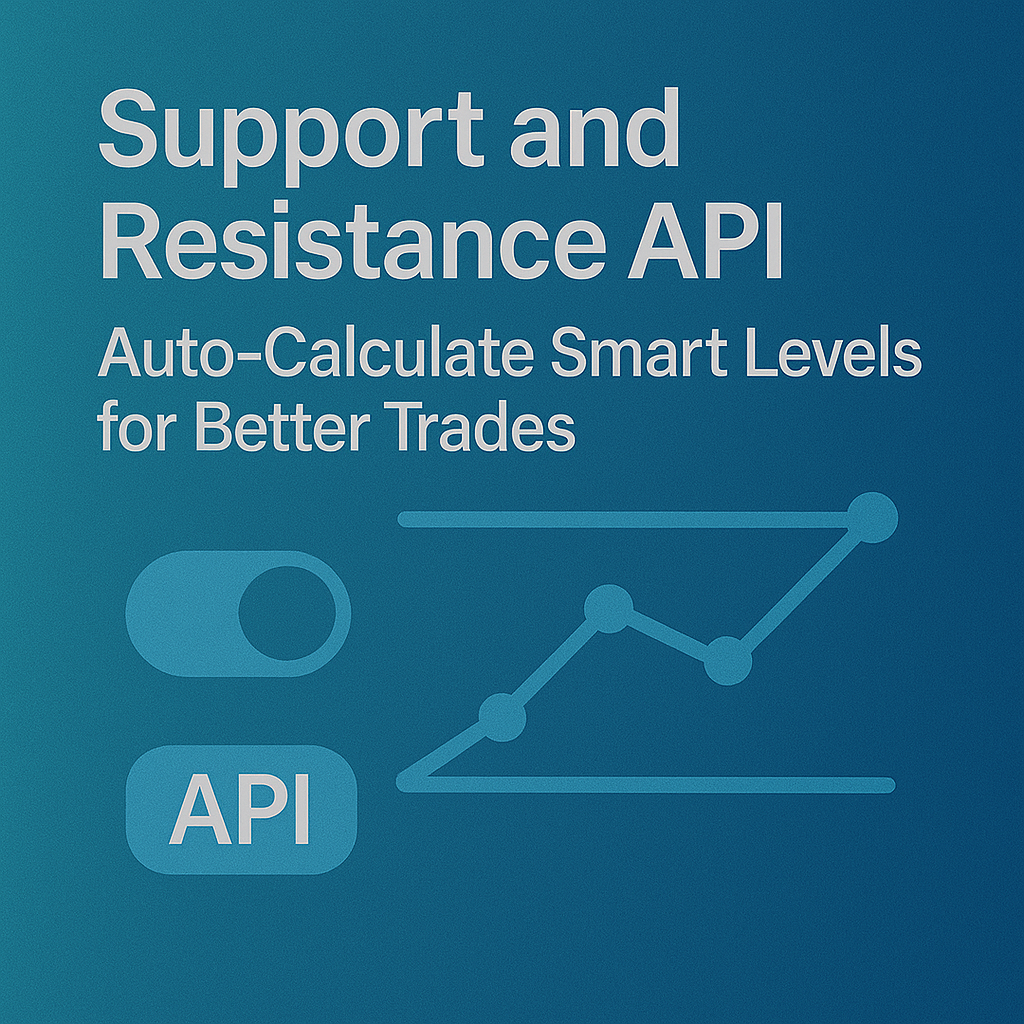Top Crypto Trading Platforms in 2025







%201.svg)
%201.svg)
Big news: We’re cranking up the heat on AI-driven crypto analytics with the launch of the Token Metrics API and our official SDK (Software Development Kit). This isn’t just an upgrade – it's a quantum leap, giving traders, hedge funds, developers, and institutions direct access to cutting-edge market intelligence, trading signals, and predictive analytics.
Crypto markets move fast, and having real-time, AI-powered insights can be the difference between catching the next big trend or getting left behind. Until now, traders and quants have been wrestling with scattered data, delayed reporting, and a lack of truly predictive analytics. Not anymore.
The Token Metrics API delivers 32+ high-performance endpoints packed with powerful AI-driven insights right into your lap, including:
Getting started with the Token Metrics API is simple:
At Token Metrics, we believe data should be decentralized, predictive, and actionable.
The Token Metrics API & SDK bring next-gen AI-powered crypto intelligence to anyone looking to trade smarter, build better, and stay ahead of the curve. With our official SDK, developers can plug these insights into their own trading bots, dashboards, and research tools – no need to reinvent the wheel.
%201.svg)
%201.svg)
The biggest gains in crypto rarely come from the majors. They come from Moonshots—fast-moving tokens with breakout potential. The Moonshots API surfaces these candidates programmatically so you can rank, alert, and act inside your product. In this guide, you’ll call /v2/moonshots, display a high-signal list with TM Grade and Bullish tags, and wire it into bots, dashboards, or screeners in minutes. Start by grabbing your key at Get API Key, then Run Hello-TM and Clone a Template to ship fast.
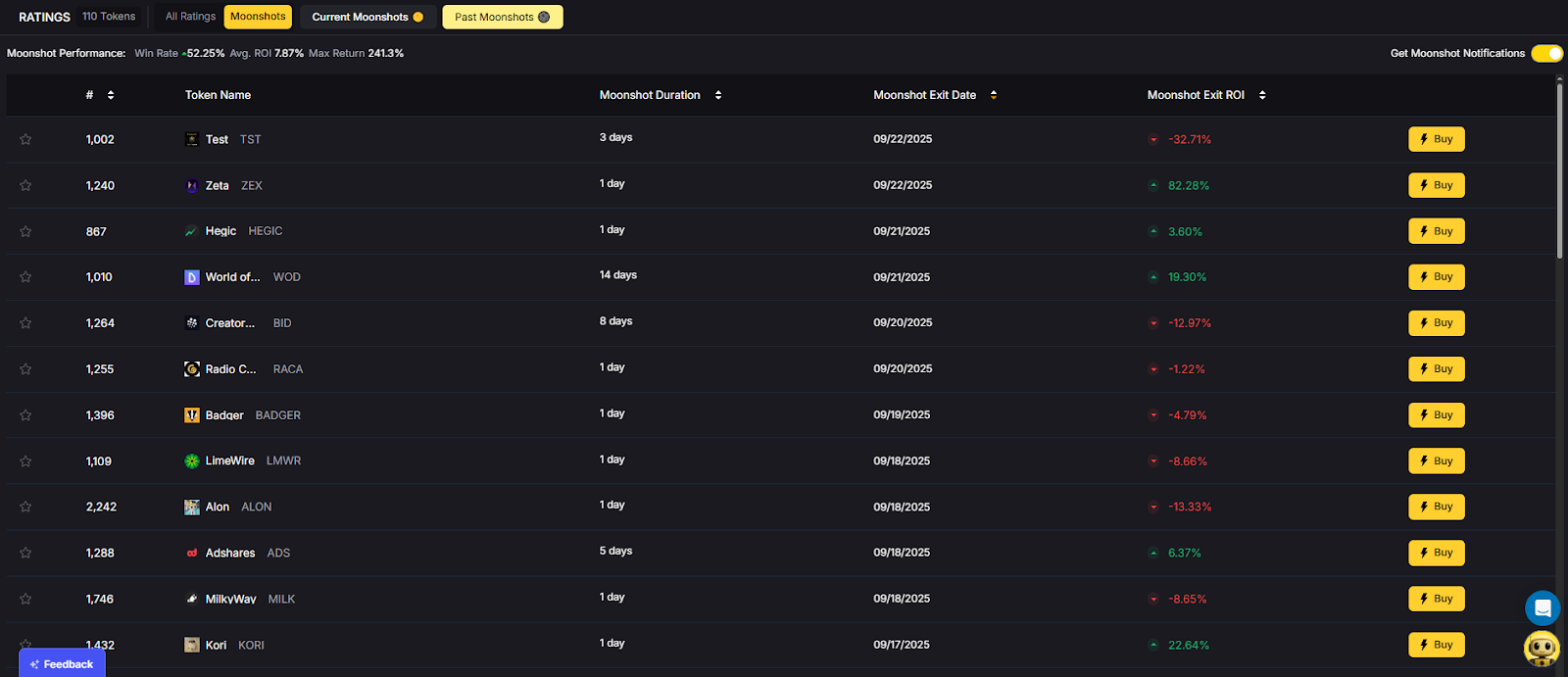
Discovery that converts. Users want more than price tickers—they want a curated, explainable list of high-potential tokens. The moonshots API encapsulates multiple signals into a short list designed for exploration, alerts, and watchlists you can monetize.
Built for builders. The endpoint returns a consistent schema with grade, signal, and context so you can immediately sort, badge, and trigger workflows. With predictable latency and clear filters, you can scale to dashboards, mobile apps, and headless bots without reinventing the discovery pipeline.
The Moonshots API cURL request is right there in the top right of the API Reference. Grab it and start tapping into the potential!
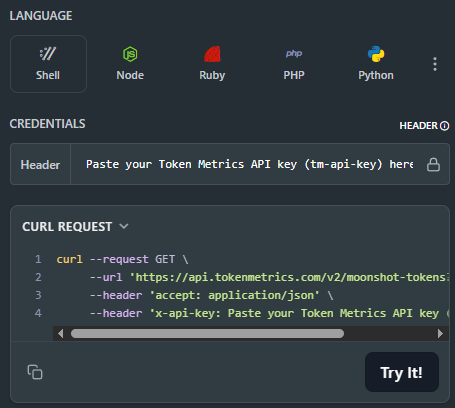
👉 Keep momentum: Get API Key • Run Hello-TM • Clone a Template
Fork a screener or alerting template, plug your key, and deploy. Validate your environment with Hello-TM. When you scale users or need higher limits, compare API plans.
The Moonshots endpoint aggregates a set of evidence—often combining TM Grade, signal state, and momentum/volume context—into a shortlist of breakout candidates. Each row includes a symbol, grade, signal, and timestamp, plus optional reason tags for transparency.
For UX, a common pattern is: headline list → token detail where you render TM Grade (quality), Trading Signals (timing), Support/Resistance (risk placement), Quantmetrics (risk-adjusted performance), and Price Prediction scenarios. This lets users understand why a token was flagged and how to act with risk controls.
Polling vs webhooks. Dashboards typically poll with short-TTL caching. Alerting flows use scheduled jobs or webhooks (where available) to smooth traffic and avoid duplicates. Always make notifications idempotent.
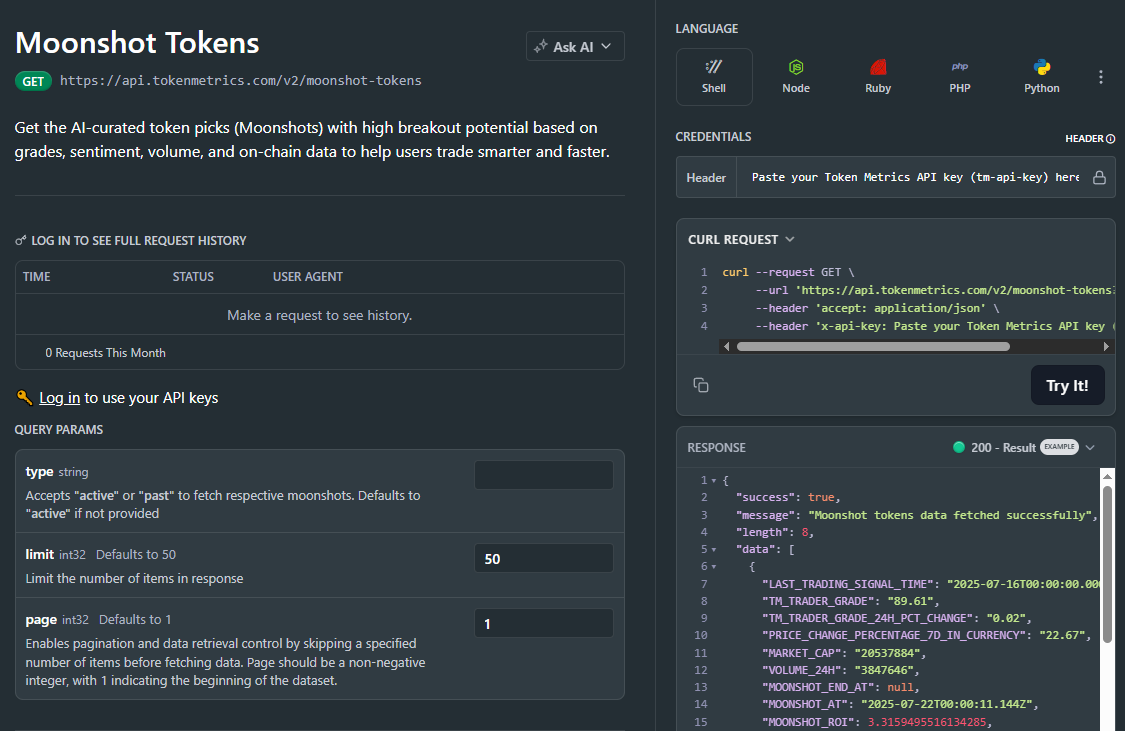
1) What does the Moonshots API return?
A list of breakout candidates with fields such as symbol, tm_grade, signal (often Bullish/Bearish), optional reason tags, and updated_at. Use it to drive discover tabs, alerts, and watchlists.
2) How fresh is the list? What about latency/SLOs?
The endpoint targets predictable latency and timely updates for dashboards and alerts. Use short-TTL caching and queued jobs/webhooks to avoid bursty polling.
3) How do I use Moonshots in a trading workflow?
Common stack: Moonshots for discovery, Trading Signals for timing, Support/Resistance for SL/TP, Quantmetrics for sizing, and Price Prediction for scenario context. Always backtest and paper-trade first.
4) I saw results like “+241%” and a “7.5% average return.” Are these guaranteed?
No. Any historical results are illustrative and not guarantees of future performance. Markets are risky; use risk management and testing.
5) Can I filter the Moonshots list?
Yes—pass parameters like min_grade, signal, and limit (as supported) to tailor to your audience and keep pages fast.
6) Do you provide SDKs or examples?
REST works with JavaScript and Python snippets above. Docs include quickstarts, Postman collections, and templates—start with Run Hello-TM.
7) Pricing, limits, and enterprise SLAs?
Begin free and scale up. See API plans for rate limits and enterprise options.
%201.svg)
%201.svg)
Most traders still draw lines by hand in TradingView. The support and resistance API from Token Metrics auto-calculates clean support and resistance levels from one request, so your dashboard, bot, or alerts can react instantly. In minutes, you’ll call /v2/resistance-support, render actionable levels for any token, and wire them into stops, targets, or notifications. Start by grabbing your key on Get API Key, then Run Hello-TM and Clone a Template to ship a production-ready feature fast.
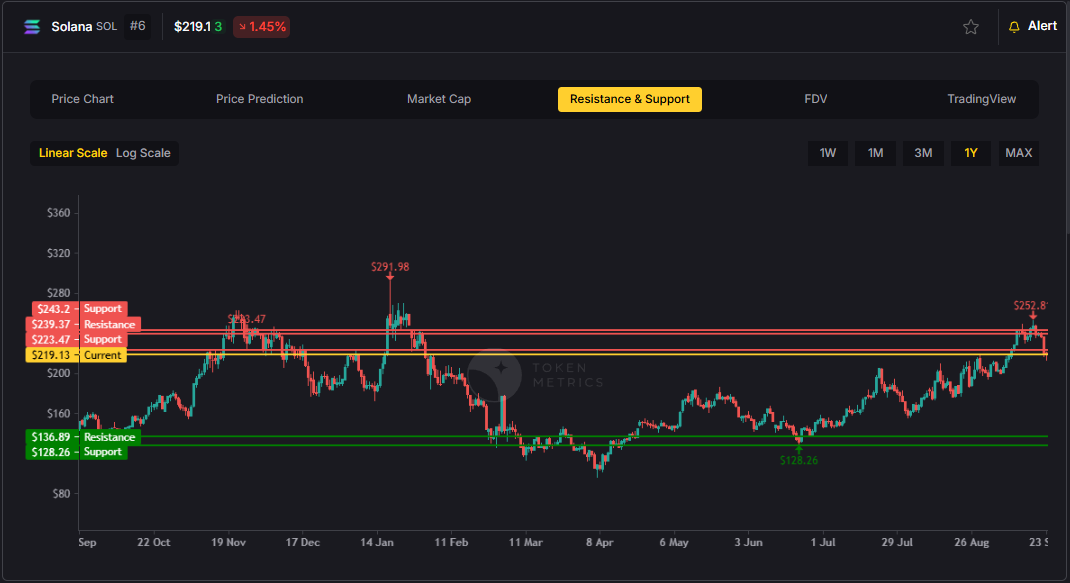
Precision beats guesswork. Hand-drawn lines are subjective and slow. The support and resistance API standardizes levels across assets and timeframes, enabling deterministic stops and take-profits your users (and bots) can trust.
Production-ready by design. A simple REST shape, predictable latency, and clear semantics let you add levels to token pages, automate SL/TP alerts, and build rule-based execution with minimal glue code.
Need the Support and Resistance data? The cURL request for it is in the top right of the API Reference for quick access.
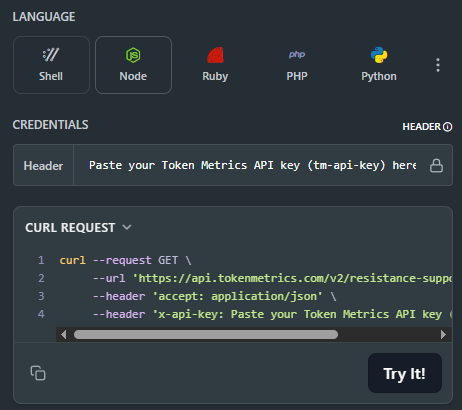
👉 Keep momentum: Get API Key • Run Hello-TM • Clone a Template
Kick off with our quickstarts—fork a bot or dashboard template, plug your key, and deploy. Confirm your environment by Running Hello-TM. When you’re scaling or need webhooks/limits, review API plans.
The Support/Resistance endpoint analyzes recent price structure to produce discrete levels above and below current price, along with strength indicators you can use for priority and styling. Query /v2/resistance-support?symbol=<ASSET>&timeframe=<HORIZON> to receive arrays of level objects and timestamps.
Polling vs webhooks. For dashboards, short-TTL caching and batched fetches keep pages snappy. For bots and alerts, use queued jobs or webhooks (where applicable) to avoid noisy, bursty polling—especially around market opens and major events.
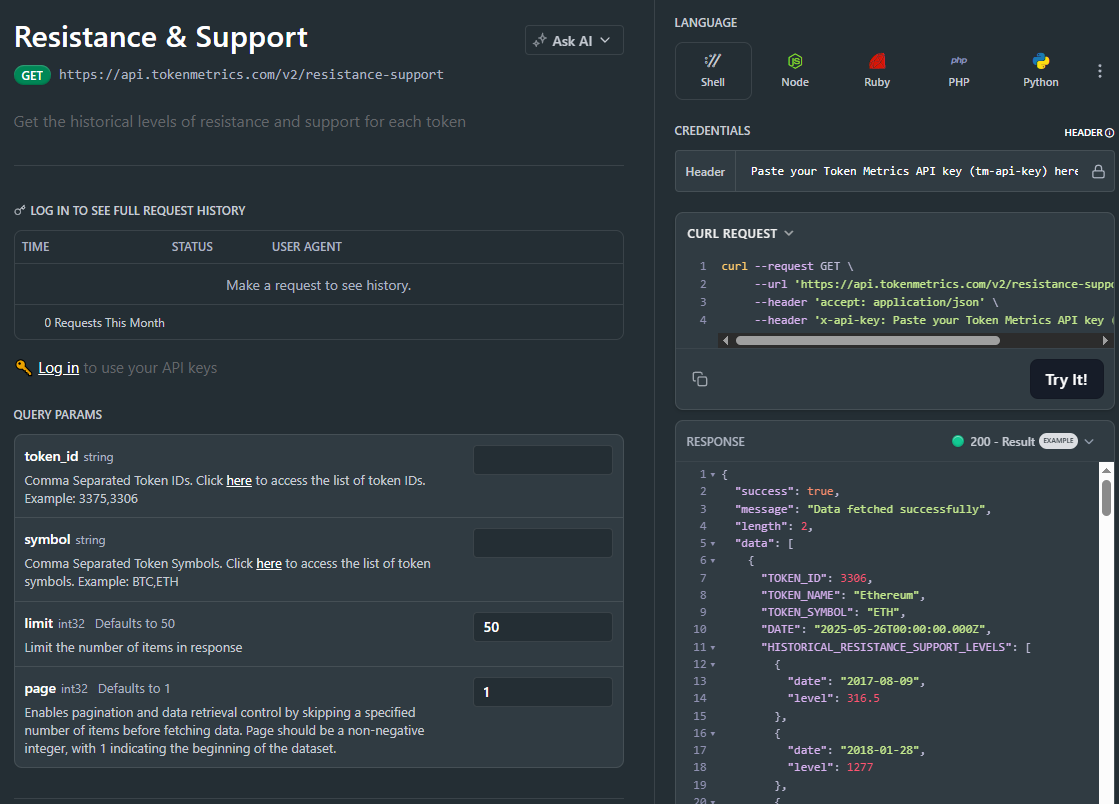
1) What does the Support & Resistance API return?
A JSON payload with arrays of support and resistance levels for a symbol (and optional timeframe), each with a price and strength indicator, plus an update timestamp.
2) How timely are the levels? What are the latency/SLOs?
The endpoint targets predictable latency suitable for dashboards and alerts. Use short-TTL caching for UIs, and queued jobs or webhooks for alerting to smooth traffic.
3) How do I trigger alerts or trades from levels?
Common patterns: alert when price is within X% of a level, touches a level, or breaks beyond with confirmation. Always make downstream actions idempotent and respect rate limits.
4) Can I combine levels with other endpoints?
Yes—pair with /v2/trading-signals for timing, /v2/tm-grade for quality context, and /v2/quantmetrics for risk sizing. This yields a complete decide-plan-execute loop.
5) Which timeframe should I use?
Intraday bots prefer shorter horizons; swing/position dashboards use daily or higher-timeframe levels. Offer a timeframe toggle and cache results per setting.
6) Do you provide SDKs or examples?
Use the REST snippets above (JS/Python). The docs include quickstarts, Postman collections, and templates—start with Run Hello-TM.
7) Pricing, limits, and enterprise SLAs?
Begin free and scale as you grow. See API plans for rate limits and enterprise SLA options.
%201.svg)
%201.svg)
Most traders see price—quants see probabilities. The Quantmetrics API turns raw performance into risk-adjusted stats like Sharpe, Sortino, volatility, drawdown, and CAGR so you can compare tokens objectively and build smarter bots and dashboards. In minutes, you’ll query /v2/quantmetrics, render a clear performance snapshot, and ship a feature that customers trust. Start by grabbing your key at Get API Key, Run Hello-TM to verify your first call, then Clone a Template to go live fast.
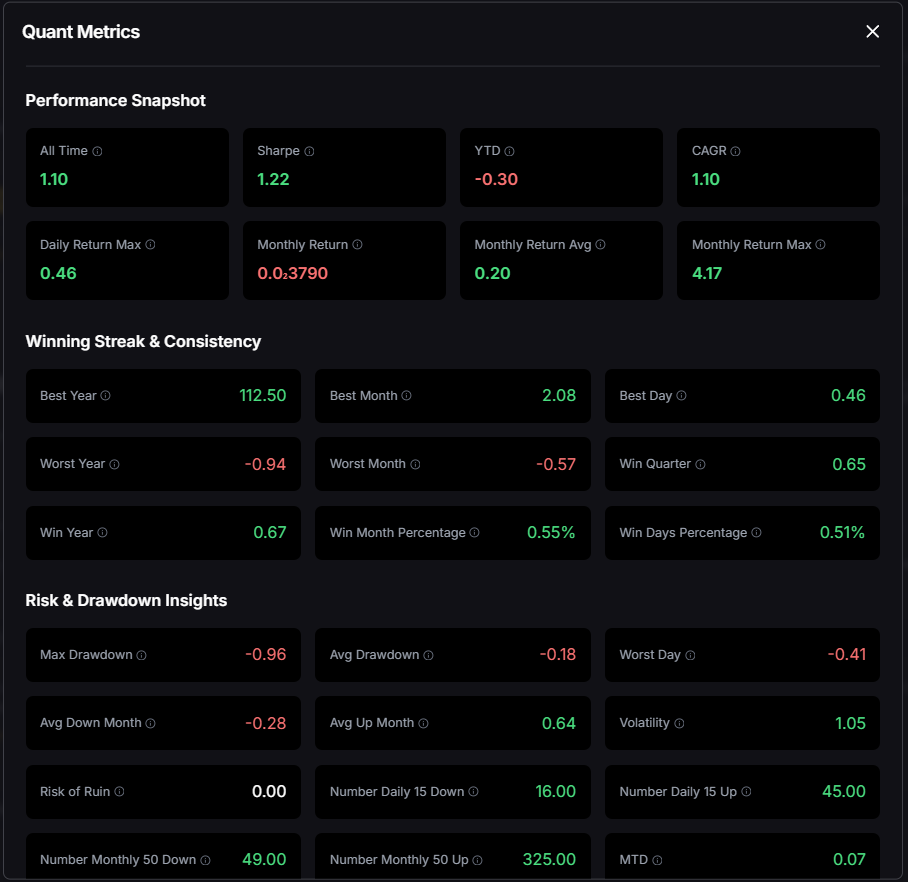
Risk-adjusted truth beats hype. Price alone hides tail risk and whipsaws. Quantmetrics compresses edge, risk, and consistency into metrics that travel across assets and timeframes—so you can rank universes, size positions, and communicate performance like a pro.
Built for dev speed. A clean REST schema, predictable latency, and easy auth mean you can plug Sharpe/Sortino into bots, dashboards, and screeners without maintaining your own analytics pipeline. Pair with caching and batching to serve fast pages at scale.
The Quant Metrics cURL request is located in the top right of the API Reference, allowing you to easily integrate it with your application.
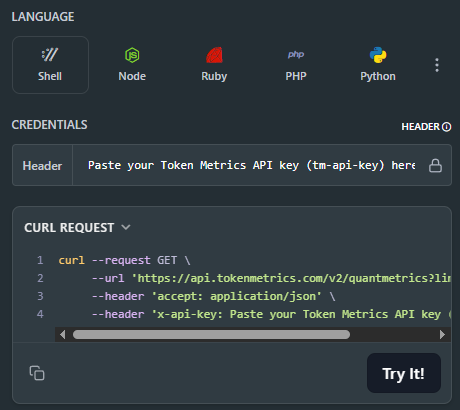
👉 Keep momentum: Get API Key • Run Hello-TM • Clone a Template
Kick off from quickstarts in the docs—fork a dashboard or screener template, plug your key, and deploy in minutes. Validate your environment with Run Hello-TM; when you need more throughput or webhooks, compare API plans.
Quantmetrics computes risk-adjusted performance over a chosen lookback (e.g., 30d, 90d, 1y). You’ll receive a JSON snapshot with core statistics:
Call /v2/quantmetrics?symbol=<ASSET>&window=<LOOKBACK> to fetch the current snapshot. For dashboards spanning many tokens, batch symbols and apply short-TTL caching. If you generate alerts (e.g., “Sharpe crossed 1.5”), run a scheduled job and queue notifications to avoid bursty polling.
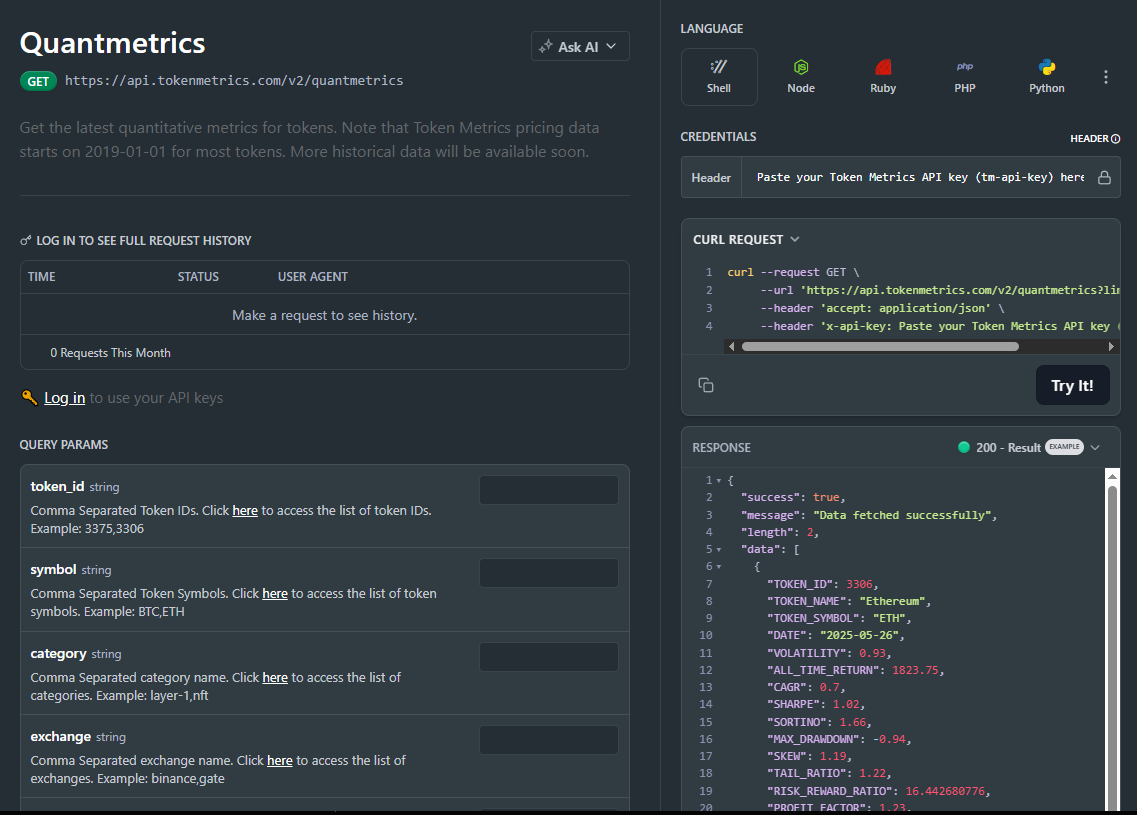
1) What does the Quantmetrics API return?
A JSON snapshot of risk-adjusted metrics (e.g., Sharpe, Sortino, volatility, max drawdown, CAGR) for a symbol and lookback window—ideal for ranking, sizing, and dashboards.
2) How fresh are the stats? What about latency/SLOs?
Responses are engineered for predictable latency. For heavy UI usage, add short-TTL caching and batch requests; for alerts, use scheduled jobs or webhooks where available.
3) Can I use Quantmetrics to size positions in a live bot?
Yes—many quants size inversely to volatility or require Sharpe ≥ X to trade. Always backtest and paper-trade before going live; past results are illustrative, not guarantees.
4) Which lookback window should I choose?
Short windows (30–90d) adapt faster but are noisier; longer windows (6–12m) are steadier but slower to react. Offer users a toggle and cache each window.
5) Do you provide SDKs or examples?
REST is straightforward (JS/Python above). Docs include quickstarts, Postman collections, and templates—start with Run Hello-TM.
6) Polling vs webhooks for quant alerts?
Dashboards usually use cached polling. For threshold alerts (e.g., Sharpe crosses 1.0), run scheduled jobs and queue notifications to keep usage smooth and idempotent.
7) Pricing, limits, and enterprise SLAs?
Begin free and scale up. See API plans for rate limits and enterprise SLA options.

%201.svg)
%201.svg)
The landscape of cryptocurrency is rapidly evolving, creating a growing demand for reliable and comprehensive data sources. For developers, analysts, and enthusiasts, crypto APIs enable access to real-time and historical market data, on-chain metrics, and other critical information necessary for data-driven decision-making. In this article, we explore what constitutes the best crypto API, with an emphasis on evaluating functionality, reliability, and the integration of advanced analytics.
A crypto API provides programmatic access to cryptocurrency market data, facilitating automated retrieval and analysis without manual intervention. These APIs typically cover aspects such as coin prices, trading volumes, order books, blockchain statistics, and sentiment signals. The best crypto API solutions ensure accuracy, low latency, and broad coverage of assets across various exchanges.
One notable provider is the Token Metrics API, which offers extensive data feeds ranging from market prices to token fundamentals combined with AI-driven analytics. Such integration supports comprehensive asset evaluation beyond mere price metrics.
Depending on use case, crypto APIs can be categorized as follows:
Choosing the most suitable crypto API involves systematically assessing several dimensions tailored to your objectives:
One advancement in the crypto data landscape is the fusion of traditional market data with artificial intelligence. Providers like Token Metrics utilize machine learning algorithms to generate token ratings and market insights. Incorporating these layers of analysis into your data workflow can streamline fundamental research and offer alternative perspectives on asset performance.
When accessing such AI-driven data via APIs, it's important to understand the methodology and limitations. Combining AI outputs with other research tools and market context improves robustness and comprehensiveness.
Successful integration of the best crypto API into your projects involves several best practices:
While APIs facilitate accessible data streams, users should remain aware of inherent challenges:
Staying informed about these factors and maintaining flexible system designs can mitigate disruption.
In sum, the best crypto API will depend on your specific data needs, technological environment, and interest in integrating advanced analytics. Platforms like the Token Metrics API stand out by combining comprehensive market data with AI-driven insights, boosting analytical capacity.
For those involved in crypto research or trading, tapping into robust APIs and leveraging AI-enhanced ratings through Token Metrics can provide valuable informational support. Always approach API data critically and complement it with diverse research tools.
This article is for educational purposes only and does not constitute financial advice. Readers should conduct independent research before making any decisions related to cryptocurrencies.

%201.svg)
%201.svg)
In the rapidly evolving world of cryptocurrencies, accessing reliable and current data is crucial for developers, analysts, and enthusiasts looking to build applications or conduct research. A cryptocurrency application programming interface (API) serves as a vital bridge, allowing users to retrieve blockchain and market data programmatically. While many crypto APIs charge fees, several free options provide substantial functionality for various use cases.
Understanding the scope, strengths, and limitations of these free crypto APIs can empower informed decisions in selecting tools that best match project requirements.
A crypto API grants programmatic access to diverse cryptocurrency data sets, including real-time prices, historical market trends, blockchain transactions, and token metrics. These interfaces are designed for ease of integration, enabling developers to incorporate crypto data into websites, mobile apps, analytical platforms, or trading engines.
For enhanced capabilities, users can explore the Token Metrics API by Token Metrics, which offers an AI-powered approach to cryptocurrency data analysis and access.
Free cryptocurrency APIs typically offer features tailored toward basic to intermediate usage. Common features include:
However, free plans may impose rate limits, reduced endpoints, or delayed data feeds compared to premium versions.
Several platforms provide free tiers with robust crypto data access. Some well-known free crypto APIs include:
For users seeking highly advanced analytics and AI-backed signals, Token Metrics offers an optimized environment accessible through its best crypto API.
While free crypto APIs lower the barrier to entry, it's important to recognize their advantages and constraints.
Selection depends on specific project needs. Consider the following:
Advanced users interested in comprehensive research tools can explore Token Metrics for deeper market and token ratings.
Artificial intelligence and machine learning are increasingly used to analyze complex crypto market data, uncover patterns, and generate actionable insights. APIs incorporating AI methods can augment traditional metrics with:
Token Metrics specializes in AI-backed crypto research, offering APIs that enhance data interpretation beyond raw numbers.
To maximize the effectiveness of free crypto API resources, consider:
Incorporating these practices helps maintain application stability and reliability.
Free crypto APIs present accessible ways to tap into valuable cryptocurrency market and blockchain data. Although there are certain limitations, many free APIs suffice for educational projects, basic analytics, and small-scale applications.
For users seeking a sophisticated solution, Token Metrics provides a comprehensive API with AI-enhanced token metrics and market analysis, bridging the gap between raw data and actionable intelligence.
Invest time in evaluating data needs, API reliability, and support resources to select the best fit. Helpful platforms include:
This article is for educational and informational purposes only. It does not constitute financial advice or recommendations. Users should conduct their own research and consult professionals before making any financial decisions.

%201.svg)
%201.svg)
In the rapidly evolving cryptocurrency ecosystem, access to reliable and up-to-date data is essential for research, analytics, and trading strategies. Free crypto APIs provide publicly accessible interfaces to gather such data without cost, enabling developers, analysts, and enthusiasts to tap into market metrics, historical data, and blockchain information. This blog post explores the fundamentals of free crypto APIs, their applications, limitations, and how AI-driven platforms like Token Metrics API can enhance data analysis.
A crypto API is an application programming interface designed to deliver cryptocurrency-related data such as price feeds, market metrics, wallet balances, transaction history, and token fundamentals. Users can integrate these APIs into their applications or systems to automate data retrieval in real-time or on-demand. Several providers offer Token Metrics APIs with varying degrees of access, including free tiers designed for basic usage and experimentation.
Free crypto APIs typically offer a subset of features found in paid versions but remain valuable for a wide range of analytical tasks. Common features include:
While free crypto APIs provide accessibility and ease of use, they come with several considerations:
Free crypto APIs serve a diverse spectrum of applications, including but not limited to:
Artificial Intelligence (AI) technologies combined with crypto APIs elevate data interpretation beyond raw figures. Platforms such as Token Metrics leverage AI-driven models to assess token fundamentals, market sentiment, and technical indicators at scale. By ingesting data from free crypto APIs, AI algorithms can generate actionable insights, ranking tokens based on multi-dimensional factors to support informed decision-making processes.
Choosing the most suitable free crypto API depends on your intended application and data requirements. Important evaluation criteria include:
Token Metrics API offers a valuable starting point for those seeking insightful token metrics and market data through an AI-powered lens. To begin:
This approach allows users to combine structured data retrieval with sophisticated analytics, providing a foundation for deeper cryptocurrency market understanding.
When using free crypto APIs, keep in mind practical measures and potential pitfalls:
Free crypto APIs are indispensable tools for accessing cryptocurrency market data efficiently and at no cost. While limitations in scope and reliability exist, these APIs provide foundational resources for learning, analysis, and developing prototypes. AI-enhanced platforms like Token Metrics paired with free crypto API access further empower users to decode complex market dynamics through algorithmic insights. Whether for academic research, application development, or integration into crypto trading platforms, understanding and leveraging available free crypto APIs is a foundational step in navigating the crypto landscape.
This article is for educational and informational purposes only and does not constitute financial or investment advice. Users should conduct their own research and consult professionals before making decisions related to cryptocurrency.

%201.svg)
%201.svg)
The blockchain ecosystem has witnessed many innovative platforms since the inception of Bitcoin. Among them, Solana has emerged as a significant player known for its high-performance capabilities. Understanding when Solana was launched provides valuable insight into its development timeline and technological evolution. This article explores the launch date and historical context of the Solana blockchain, its technological foundations, and resources for further research, including analytical tools such as Token Metrics.
Solana is a high-throughput blockchain platform designed to support decentralized applications and crypto-currencies with a strong emphasis on scalability and low transaction costs. Its architecture leverages unique consensus mechanisms and innovations in cryptographic technology that distinguish it from other platforms. These features aim to solve common blockchain challenges such as network congestion and high fees.
Solana's development began several years before its mainnet launch, with foundational research conducted by its creator, Anatoly Yakovenko, starting in 2017. The project's codebase and whitepapers were gradually developed over the next couple of years. The key milestone of Solana’s live network, or mainnet beta, occurred on March 16, 2020.
This mainnet beta launch marked the transition from development and internal testing stages to a public network where users could transact, stake tokens, and deploy applications. However, it is important to note that the label “beta” indicated that the network was still under active development and subject to updates and improvements.
At the time of its launch, Solana introduced several novel technological elements, including:
The combination of these technologies aimed to allow Solana to process more transactions per second than many existing blockchains at the time.
Following the March 2020 mainnet beta launch, Solana's development continued rapidly. The development team released multiple updates enhancing network stability, introducing new features, and scaling capacity. Key phases included the transition from beta to a more stable production environment and expanding ecosystem support through developer tools and partnerships.
Community growth, validator participation, and decentralized application deployment increased steadily, underscoring the network’s rising prominence in the blockchain space.
For those interested in a deeper understanding of Solana’s origins and ongoing development, the following approaches are useful:
Artificial intelligence has enhanced the capacity to analyze complex blockchain data and market trends. Tools like Token Metrics apply machine learning algorithms to process large datasets, offering neutral ratings and analytics that can support educational research into platforms like Solana.
While such tools do not provide investment advice, they offer frameworks to understand project fundamentals, technological developments, and market sentiment — all essential elements for comprehensive analysis.
This article is intended for educational purposes only. It does not provide financial, investment, or trading advice. Readers should conduct thorough research and consider multiple sources before making decisions related to cryptocurrencies or blockchain technologies.

%201.svg)
%201.svg)
Solana has emerged as one of the notable projects in the blockchain ecosystem, known for its high-performance capabilities and growing developer community. Understanding how to buy Solana (SOL) requires familiarity with the ecosystem, secure wallets, and the exchanges where the token is available. This guide presents an educational overview on acquiring Solana tokens while highlighting the tools and approaches that can support your research process efficiently.
Before proceeding with any acquisition, it helps to understand the fundamentals of the Solana blockchain. Solana is a decentralized network designed to enable fast, scalable decentralized applications (dApps) and crypto assets. Its native token, SOL, is used for transaction fees and interacting with applications on the network.
Awareness of Solana's technological framework, including its unique Proof of History consensus mechanism, provides context that informs the buying process from both a technical standpoint and an operational perspective.
Acquiring SOL tokens necessitates having a compatible wallet that supports Solana’s blockchain.
Choosing a wallet depends on individual preferences balancing convenience and security considerations.
SOL tokens are available on multiple cryptocurrency exchanges, but purchasing involves selecting a platform based on liquidity, fees, regulatory compliance, and user experience.
Common exchange options include:
Researching exchange reputation, fee structures, and security protocols is an important step and can be supplemented by analysis tools.
Utilizing AI-powered research platforms enhances the ability to analyze blockchain projects systematically. Token Metrics is one such platform offering data-driven insights, ratings, and scenario analyses. These tools help decode market trends, evaluate fundamentals, and monitor technical developments, supporting an informed understanding of Solana’s evolving landscape.
While such platforms provide valuable educational support, users should integrate various sources and maintain ongoing research to navigate the dynamic crypto environment responsibly.
When buying Solana or any cryptocurrency, security is paramount. Consider the following precautions:
Acquiring Solana tokens involves understanding the blockchain’s underlying technology, selecting the right wallet, choosing a reliable exchange, and practicing robust security measures. Leveraging AI-powered analytical tools like Token Metrics can deepen research capabilities and facilitate a comprehensive approach to exploring the crypto space.
This content is provided solely for educational and informational purposes. It is not financial, investment, tax, or legal advice. Readers should perform their own research and consult with licensed professionals before making any financial decisions related to cryptocurrencies.

%201.svg)
%201.svg)
Ethereum is one of the most influential blockchain platforms developed since Bitcoin. It extends the concept of a decentralized ledger by integrating a programmable layer that enables developers to build decentralized applications (dApps) and smart contracts. This blog post explores how Ethereum operates technically and functionally without delving into investment aspects.
At its core, Ethereum operates as a distributed ledger technology—an immutable blockchain maintained by a decentralized network of nodes. These nodes collectively maintain and validate the Ethereum blockchain, which records every transaction and smart contract execution.
The Ethereum blockchain differs from Bitcoin primarily through its enhanced programmability and faster block times. Ethereum’s block time averages around 12-15 seconds, which allows for quicker confirmation of transactions and execution of contracts.
A fundamental innovation introduced by Ethereum is the smart contract. Smart contracts are self-executing pieces of code stored on the blockchain, triggered automatically when predefined conditions are met.
The Ethereum Virtual Machine (EVM) is the runtime environment for smart contracts. It interprets the contract code and operates across all Ethereum nodes to ensure consistent execution. This uniformity enforces the trustless and decentralized nature of applications built on Ethereum.
Originally, Ethereum used a Proof of Work (PoW) consensus mechanism similar to Bitcoin, requiring miners to solve complex cryptographic puzzles to confirm transactions and add new blocks. However, Ethereum has transitioned to Proof of Stake (PoS) through an upgrade called Ethereum 2.0.
In the PoS model, validators are chosen to propose and validate blocks based on the amount of cryptocurrency they stake as collateral. This method reduces energy consumption and improves scalability and network security.
Executing transactions and running smart contracts on Ethereum requires computational resources. These are measured in units called gas. Users pay gas fees, denominated in Ether (ETH), to compensate validators for processing and recording the transactions.
The gas fee varies depending on network demand and the complexity of the operation. Simple transactions require less gas, while complex contracts or high congestion periods incur higher fees. Gas mechanics incentivize efficient code and prevent spam on the network.
Ethereum’s decentralization is maintained by nodes located worldwide. These nodes can be categorized as full nodes, which store the entire blockchain and validate all transactions, and light nodes, which store only essential information.
Anyone can run a node, contributing to Ethereum’s resilience and censorship resistance. Validators in PoS must stake Ether to participate in block validation, ensuring alignment of incentives for network security.
Decentralized applications (dApps) are built on Ethereum’s infrastructure. These dApps span various sectors, including decentralized finance (DeFi), supply chain management, gaming, and digital identity. The open-source nature of Ethereum encourages innovation and interoperability across platforms.
Understanding Ethereum’s intricate network requires access to comprehensive data and analytical tools. AI-driven platforms, such as Token Metrics, utilize machine learning to evaluate on-chain data, developer activity, and market indicators to provide in-depth insights.
Such platforms support researchers and users by offering data-backed analysis, helping to comprehend Ethereum’s evolving technical landscape and ecosystem without bias or financial recommendations.
Ethereum revolutionizes blockchain technology by enabling programmable, trustless applications through smart contracts and a decentralized network. Transitioning to Proof of Stake enhances its scalability and sustainability. Understanding its mechanisms—from the EVM to gas fees and network nodes—provides critical perspectives on its operation.
For those interested in detailed Ethereum data and ratings, tools like Token Metrics offer analytical resources driven by AI and machine learning to keep pace with Ethereum’s dynamic ecosystem.
This content is for educational and informational purposes only. It does not constitute financial, investment, or trading advice. Readers should conduct independent research and consult professionals before making decisions related to cryptocurrencies or blockchain technologies.

%201.svg)
%201.svg)
Ethereum mining has been an essential part of the Ethereum blockchain network, enabling transaction validation and new token issuance under a Proof-of-Work (PoW) consensus mechanism. As Ethereum evolves, understanding the fundamentals of mining, the required technology, and operational aspects can provide valuable insights into this cornerstone process. This guide explains the key components of Ethereum mining, focusing on technical and educational details without promotional or financial advice.
Ethereum mining involves validating transactions and securing the network by solving complex mathematical problems using computational resources. Miners employ high-performance hardware to perform hashing calculations and compete to add new blocks to the blockchain. Successfully mined blocks reward miners with Ether (ETH) generated through block rewards and transaction fees.
At its core, Ethereum mining requires:
GPU-based mining rigs are currently the standard hardware for Ethereum mining due to their efficiency in processing the Ethash PoW algorithm. Graphics Processing Units (GPUs) are well-suited for the memory-intensive hashing tasks required for Ethereum, as opposed to ASICs (Application-Specific Integrated Circuits) that tend to specialize in other cryptocurrencies.
Key considerations when selecting GPUs include:
Popular GPUs such as the Nvidia RTX and AMD RX series often top mining performance benchmarks. However, hardware availability and electricity costs significantly impact operational efficiency.
Once mining hardware is selected, the next step involves configuring mining software suited for Ethereum. Mining software translates computational tasks into actionable processes executed by the hardware while connecting to the Ethereum network or mining pools.
Common mining software options include:
When configuring mining software, consider settings related to:
Mining Ethereum independently can be challenging due to increasing network difficulty and competition. Mining pools provide cooperative frameworks where multiple miners combine computational power to improve chances of mining a block. Rewards are then distributed proportionally according to contributed hash power.
Benefits of mining pools include:
Popular mining pools for Ethereum include Ethermine, SparkPool, and Nanopool. When selecting a mining pool, evaluate factors such as fees, payout methods, server locations, and minimum payout thresholds.
Mining Ethereum incurs ongoing costs, primarily electricity consumption and hardware maintenance. Efficiency optimization entails balancing power consumption with mining output to ensure sustainable operations.
Key factors to consider include:
Understanding power consumption (wattage) of mining rigs relative to their hashrate assists in determining energy efficiency. For example, a rig with a hashrate of 60 MH/s consuming 1200 watts has different efficiency metrics compared to others.
Efficient mining operations benefit from monitoring tools that track hardware performance, network status, and market dynamics. Analytical platforms offer data-backed insights that can guide equipment upgrades, pool selection, and operational adjustments.
Artificial intelligence-driven research platforms like Token Metrics provide quantitative analysis of Ethereum network trends and mining considerations. Leveraging such tools can optimize decision-making by integrating technical data with market analytics without endorsing specific investment choices.
Ethereum’s transition from Proof-of-Work to Proof-of-Stake (PoS), known as Ethereum 2.0, represents a significant development that impacts mining practices. PoS eliminates traditional mining in favor of staking mechanisms, which means Ethereum mining as performed today may phase out.
Miners should remain informed about network upgrades and consensus changes through official channels and reliable analysis platforms like Token Metrics. Understanding potential impacts enables strategic planning related to hardware usage and participation in alternative blockchain activities.
This article is intended for educational purposes only. It does not offer investment advice, price predictions, or endorsements. Readers should conduct thorough individual research and consider multiple reputable sources before engaging in Ethereum mining or related activities.

%201.svg)
%201.svg)
The digital landscape is continually evolving, giving rise to a new paradigm known as Web 3. This iteration promises a shift towards decentralization, enhanced user control, and a more immersive internet experience. But what exactly is Web 3, and why is it considered a transformative phase of the internet? This article explores its fundamentals, technology, potential applications, and the tools available to understand this complex ecosystem.
Web 3, often referred to as the decentralized web, represents the next generation of internet technology that aims to move away from centralized platforms dominated by a few major organizations. Instead of relying on centralized servers, Web 3 utilizes blockchain technology and peer-to-peer networks to empower users and enable trustless interactions.
In essence, Web 3 decentralizes data ownership and governance, allowing users to control their information and digital assets without intermediaries. This marks a significant departure from Web 2.0, where data is predominantly managed by centralized corporations.
Several emerging technologies underpin the Web 3 movement, each playing a vital role in achieving its vision:
Together, these technologies provide a robust foundation for a more autonomous and transparent internet landscape.
Understanding Web 3 requires comparing it to its predecessor, Web 2:
This shift fosters a more user-centric, permissionless, and transparent internet experience.
Web 3's decentralized infrastructure unlocks numerous application possibilities across industries:
As Web 3 matures, the range of practical and innovative use cases is expected to expand further.
Despite its promise, Web 3 faces several hurdles that need attention:
Addressing these challenges is crucial for realizing the full potential of Web 3.
For individuals and organizations interested in understanding Web 3 developments, adopting a structured research approach is beneficial:
This approach supports informed analysis based on technology fundamentals rather than speculation.
Artificial intelligence technologies complement Web 3 by enhancing research and analytical capabilities. AI-driven platforms can process vast amounts of blockchain data to identify patterns, assess project fundamentals, and forecast potential developments.
For example, Token Metrics integrates AI methodologies to provide insightful ratings and reports on various Web 3 projects and tokens. Such tools facilitate more comprehensive understanding for users navigating decentralized ecosystems.
Web 3 embodies a transformative vision for the internet—one that emphasizes decentralization, user empowerment, and innovative applications across multiple sectors. While challenges remain, its foundational technologies like blockchain and smart contracts hold substantial promise for reshaping digital interactions.
Continuing research and utilization of advanced analytical tools like Token Metrics can help individuals and organizations grasp Web 3’s evolving landscape with clarity and rigor.
This article is for educational and informational purposes only and does not constitute financial, investment, or legal advice. Readers should conduct their own research and consult with professional advisors before making any decisions related to Web 3 technologies or digital assets.

%201.svg)
%201.svg)
The explosion of interest in non-fungible tokens (NFTs) has opened new opportunities for creators and collectors alike. If you've ever wondered, "How can I mint my own NFT?", this guide will walk you through the essential concepts, processes, and tools involved in creating your unique digital asset on the blockchain.
Minting an NFT refers to the process of turning a digital file — such as artwork, music, video, or other digital collectibles — into a unique token recorded on a blockchain. This tokenization certifies the originality and ownership of the asset in a verifiable manner. Unlike cryptocurrencies, NFTs are unique and cannot be exchanged on a one-to-one basis.
Several blockchains support NFT minting, each with distinct features, costs, and communities. The most popular blockchain for NFTs has been Ethereum due to its widespread adoption and support for ERC-721 and ERC-1155 token standards. However, alternatives such as Binance Smart Chain, Solana, Polygon, and Tezos offer different advantages, such as lower transaction fees or faster processing times.
When deciding where to mint your NFT, consider factors like network fees (also known as gas fees), environmental impact, and marketplace support. Analytical tools, including Token Metrics, can offer insights into blockchain performance and trends, helping you make an informed technical decision.
Once you have chosen a blockchain, the next step is to select an NFT platform that facilitates minting and listing your digital asset. Popular NFT marketplaces such as OpenSea, Rarible, Foundation, and Mintable provide user-friendly interfaces to upload digital files, set metadata, and mint tokens.
Some platforms have specific entry requirements, such as invitation-only access or curation processes, while others are open to all creators. Consider the platform's user base, fees, minting options (e.g., lazy minting or direct minting), and supported blockchains before proceeding.
Minting an NFT typically involves transaction fees known as gas fees, which vary based on blockchain network congestion and platform policies. Costs can fluctuate significantly; therefore, it's prudent to monitor fee trends, potentially using analytical resources like Token Metrics to gain visibility into network conditions.
Some NFT platforms offer "lazy minting," allowing creators to mint NFTs with zero upfront fees, with costs incurred only upon sale. Understanding these financial mechanics is crucial to planning your minting process efficiently.
The intersection of artificial intelligence and blockchain has produced innovative tools that assist creators and collectors throughout the NFT lifecycle. AI can generate creative artwork, optimize metadata, and analyze market trends to inform decisions.
Research platforms such as Token Metrics utilize AI-driven methodologies to provide data insights and ratings that support neutral, analytical understanding of blockchain assets, including aspects relevant to NFTs. Employing such tools can help you better understand the technical fundamentals behind NFT platforms and ecosystems.
Minting your own NFT involves understanding the technical process of creating a unique token on a blockchain, choosing appropriate platforms, managing costs, and utilizing supporting tools. While the process is accessible to many, gaining analytical insights and leveraging AI-driven research platforms such as Token Metrics can deepen your understanding of underlying technologies and market dynamics.
This article is for educational purposes only and does not constitute financial or investment advice. Always conduct your own research and consult professionals before engaging in digital asset creation or transactions.


 Create Your Free Account
Create Your Free Account9450 SW Gemini Dr
PMB 59348
Beaverton, Oregon 97008-7105 US
.svg)




.png)
Token Metrics Media LLC is a regular publication of information, analysis, and commentary focused especially on blockchain technology and business, cryptocurrency, blockchain-based tokens, market trends, and trading strategies.
Token Metrics Media LLC does not provide individually tailored investment advice and does not take a subscriber’s or anyone’s personal circumstances into consideration when discussing investments; nor is Token Metrics Advisers LLC registered as an investment adviser or broker-dealer in any jurisdiction.
Information contained herein is not an offer or solicitation to buy, hold, or sell any security. The Token Metrics team has advised and invested in many blockchain companies. A complete list of their advisory roles and current holdings can be viewed here: https://tokenmetrics.com/disclosures.html/
Token Metrics Media LLC relies on information from various sources believed to be reliable, including clients and third parties, but cannot guarantee the accuracy and completeness of that information. Additionally, Token Metrics Media LLC does not provide tax advice, and investors are encouraged to consult with their personal tax advisors.
All investing involves risk, including the possible loss of money you invest, and past performance does not guarantee future performance. Ratings and price predictions are provided for informational and illustrative purposes, and may not reflect actual future performance.

